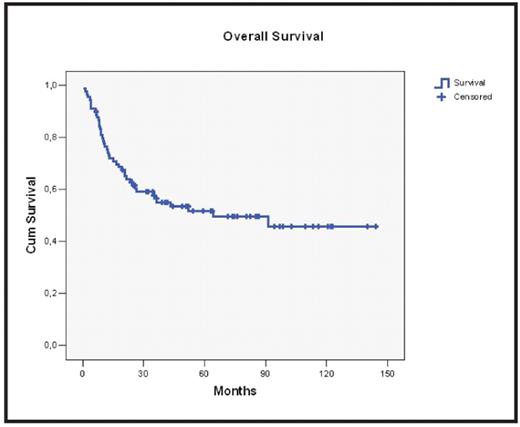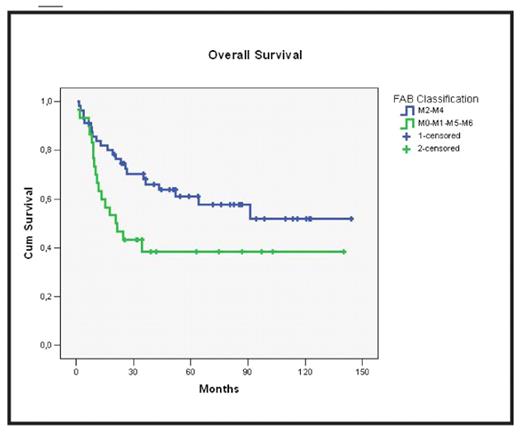Abstract
We report our results of ASCT in patients with Acute Myeloid Leukemia (AML) during the last 16 years. Between December 1991 and december 2007, 90 patients with AML received an ASCT. The main characteristics were reported on table 1. The median patient age was 46 years (range17 – 67 years). The conditioning regimen employed for all patients was Busulphan + Cyclophosfamide. The Overall Survival (OS) (Figure1) was 53,5% with a median follow up of 91,6 months. The majority of patients (81) was transplanted in first complete remission (1st CR), 8 in 2nd CR and 1 >2nd CR. The OS considering the disease phase at transplant was different: 55,7% vs 16,7%, p < 0,01 (one pts with > second CR was excluded from analysis). If we considering also the age stratified in two groups: 17–45 vs 46–67 years, all patients in second CR, included into II group died. We have calculated OS stratified for age in these groups that was 46,2% versus 59,6%, respectively, without statistical differences. We also analyzed the OS distributed for sex and cell source without statistical difference. We have documented a statistically significant correlation between FAB group and survival (Figure 2). In fact, the patients with FAB M2 and M4 (excluded M3) had a superior OS than those with other FAB (60,7% vs 40%, p < 0.019)). In 32/40 (80%) patients, the relapse has been documented within 24 months from transplant. The analysis for cytogenetic risk has been performed, but considering only 46 patients assessable. The OS cytogenetic risk-related was 87% for 8 patients with Low Risk, 47% for 36 patients with Intermediate Risk, 2 patients with High Risk died within 11 months from transplant (data not shown). We conclude that autologous bone marrow transplantation is an effective treatment in AML with the possibility of long survivorship, particularly in patients with FAB M2 and M4. In our experience, first complete remission of disease at transplant play an important role and correlates with the longest survival. The analysis of cytogenetic risk reflects the impact of karyotype on OS. Transplant Related Mortality (TRM) has been documented in 6/90 patients, all died before the years 2000.
Table 1
| Number of patientss . | 90 . |
|---|---|
| Sex (M/F) | 42/48 |
| Age (range y) (mean ±SD y) | 17–67 46,3±11,4 |
| FAB classification: | |
| M0 | 2 (2,2%) |
| M1 | 16 (17,8%) |
| M2 | 28 (31,1%) |
| M3 | 4 (4,4%) |
| M4 | 28 (31,1%) |
| M5 | 11(12,3%) |
| M6 | |
| Phase of disease: | 1 (1,1%) |
| 1st Complete Remission | 81 (90%) |
| 2nd Complete remission | 8 (8,9%) |
| > 2nd Complete Remission | 1 (1,1%) |
| Citogenetic risk (pts evaluable: 46) | |
| Low | 8 (17,3%) |
| Intermediate | 36 (78,2%) |
| High | 2 (4,5%) |
| Transplant Related Mortality | 6/90 (6,7%) |
| Number of patientss . | 90 . |
|---|---|
| Sex (M/F) | 42/48 |
| Age (range y) (mean ±SD y) | 17–67 46,3±11,4 |
| FAB classification: | |
| M0 | 2 (2,2%) |
| M1 | 16 (17,8%) |
| M2 | 28 (31,1%) |
| M3 | 4 (4,4%) |
| M4 | 28 (31,1%) |
| M5 | 11(12,3%) |
| M6 | |
| Phase of disease: | 1 (1,1%) |
| 1st Complete Remission | 81 (90%) |
| 2nd Complete remission | 8 (8,9%) |
| > 2nd Complete Remission | 1 (1,1%) |
| Citogenetic risk (pts evaluable: 46) | |
| Low | 8 (17,3%) |
| Intermediate | 36 (78,2%) |
| High | 2 (4,5%) |
| Transplant Related Mortality | 6/90 (6,7%) |
Disclosures: No relevant conflicts of interest to declare.
Author notes
Corresponding author



This feature is available to Subscribers Only
Sign In or Create an Account Close Modal